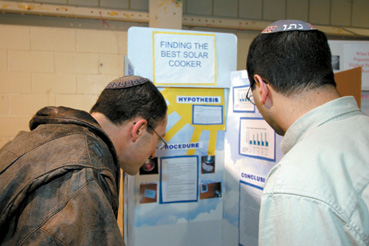Kids’ fair yields impressive science projects
Published February 27, 2006
Seventh-grade student Josh Goldmeier and his mother, Bonnie, rushed to put some last minute touches on Josh’s science fair project display board. His experiment had looked at the effect of acid rain on the growth of plants. Said Josh, “I decided to do this project because of all the pollution in the air. I think in the long run it hurts our plants.” Unfortunately for all of us, Josh concluded his hypothesis is right: Pollution is killing the plants.
Josh’s project was one of more than 60 on display for H.F. Epstein Hebrew Academy’s Annual Science Fair. Science teacher Kathleen Naudi was very pleased with all the completed projects. “The students have all worked incredibly hard and done a tremendous amount of work,” Naudi said. Sixth- through eighth-grade students did individual or team projects, and first through fifth grades did entire class projects. Three judges from Pfizer were responsible for choosing the 15 projects to go on the Greater St. Louis Science Fair.
Research scientist Mark Abrams, biochemist Katrina Kearns and scientist Brett Wimberly looked for overall completeness of the projects — log books, reports and the final displays — as they made their decisions. They were all excited to see the students involved and getting their start liking science. Said Kearns, “When they participate in a fair like this they see that science is accessible.”
“I love to see how kids develop their projects and a strong science background early in their lives. I enjoy being a part of it and helping them along,” said Wimberly.
Abrams has fifth-grade twin sons Menasha and Ephraim attending the school and a daughter who has graduated. Abrams said, “It is fun to see how young minds set up their experiments. About 10 years ago the thing to be into was computers. It’s wonderful to see the renewed interest in science.”
Naudi said: “The students grow in terms of critical thinking skills, problem solving and scientific knowledge and it carries over into their everyday lives. They take a lot of pride in their projects, especially today when they put them on display. They gave it their best. It produces a lot of positive energy that hangs around for a while.”
A few of the students actually began their projects before the school year even started. Naudi said, “They knew their ideas and started the research over the summer. It’s exactly what you would hope for.”
The projects covered topics from the familiar to the unique. Several looked at memory and how it is affected by different factors such as gender or eating breakfast. One project looked the effect of high glucose levels in type one diabetic adolescents on their short-term memory.
Some other projects looked at: variables affecting the ability to remove stains from fabric and clothing, how long different brands of batteries last, which microwave popcorn pops the best, the fat content in potato chips and how well do hand cleaners really clean. A few of the projects looked at consumer marketing concerns such as: national brands versus store brands and which primary color attracts the human eye.
On the day of the judging several parents and students did some last-minute taping and gluing as they set up the displays. It was clear the families had to “do science” as well from the acknowledgments in the log books and reports. The students gave thanks to their parents, siblings, grandparents, friends, science teacher and the “library lady” for helping with research.
Head of school Rabbi Shmuel Kay said, “I am very proud of how hard the students worked and the professionalism of their science teacher, Kathleen Naudi. Our special science fair evening gave parents, families and friends an opportunity to see the finished projects with students on hand to explain their work.” The projects were displayed all week in the halls at the school.
The projects selected for entry into the Greater St. Louis Science Fair are: Chaya Andrew, sixth grade, “Do Consumers Think National Brands Are Better Than Store Brands?”; Rena Biel and Adira Axelbaum, seventh grade, “Evaporation or No Evaporation”; Marina Bolotnikova, eighth grade, “The Effect of Temperature on pH”; Josh Goldmeier, eighth grade, “What Goes Up Must Come Down”; Natanela Kenigsberg, seventh grade, “What Is the Minimum Weight Tolerated By Different Dome Shapes?”; Tamara Levy, seventh grade, “Mold, Mold, Everywhere; Gabi Mankowitz, seventh grade, “One Fish, Two Fish, Three Smart Goldfish”; Rebecca and Shira Mogil, seventh/sixth grade, “How Clean Are Your Hands”; Eliana Parnas, seventh grade, “Phreaky Philodendrons”; Jasmine Raskas, sixth grade, “The Science of Lava Lamps”; Aniel Shapiro, sixth grade, “Finding the Best Solar Cooker”; Ellie Sonnenwirth, eighth grade, “Test Before You Test”; Batsheva Sundy, sixth grade, “The pH Determination of Various Orange Juices”; Ben Weintraub, eighth grade, “Battery Battle”; and Rebecca Wilhelm, seventh grade, “Adolescents in Crisis: What Kids Should Know About Their Health Habits.”















